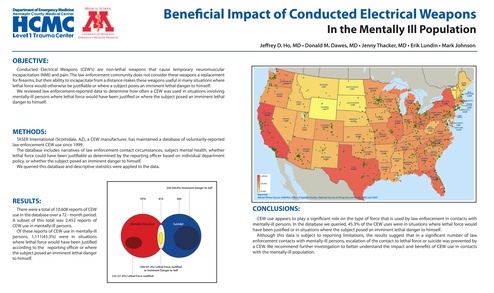Taser Beneficial Impact of Conducted Electrical Weapons for Mentally Ill Minnesota
Download original document:

Document text

Document text
This text is machine-read, and may contain errors. Check the original document to verify accuracy.
Beneficial Impact of Conducted Electrical Weapons MEDICAL SCHOOL In the Mentally Ill Population UNIVERSITY OF MINNESOTA EMERGENCY MEDICINE PROGRAM Jeffrey D. Ho, MD • Donald M. Dawes, MD • Jenny Thacker, MD • Erik Lundin • Mark Johnson OBJECTIVE: Conducted Electrical Weapons (CEW’s) are non-lethal weapons that cause temporary neuromuscular incapacitation (NMI) and pain. The law enforcement community does not consider these weapons a replacement for firearms, but their ability to incapacitate from a distance makes these weapons useful in many situations where lethal force would otherwise be justifiable or where a subject poses an imminent lethal danger to himself. We reviewed law enforcement-reported data to determine how often a CEW was used in situations involving mentally-ill persons where lethal force would have been justified or where the subject posed an imminent lethal danger to himself. WASHINGTON 109 EDP MONTANA 6 EDP NORTH DAKOTA 2 EDP VERMONT MINNESOTA 103 EDP MAINE 5 EDP 1 EDP NEW HAMPSHIRE 13 EDP OREGON 47 EDP IDAHO 2 EDP WISCONSIN 135 EDP SOUTH DAKOTA 6 EDP MICHIGAN 75 EDP NEW YORK 25 EDP WYOMING 3 EDP PENNSYLVANIA 82 EDP CALIFORNIA 159 EDP NEVADA 13 EDP NEBRASKA 46 EDP UTAH 30 EDP METHODS: IOWA 17 EDP COLORADO 129 EDP INDIANA 26 EDP OHIO 149 EDP WEST VERGINIA 6 EDP MISSOURI 105 EDP KANSAS 34 EDP TASER International (Scottsdale, AZ), a CEW manufacturer, has maintained a database of voluntarily-reported law enforcement CEW use since 1999. The database includes narratives of law enforcement contact circumstances, subject mental health, whether lethal force could have been justifiable as determined by the reporting officer based on individual department policy, or whether the subject posed an imminent danger to himself. We queried this database and descriptive statistics were applied to the data. ILLINOIS 33 EDP KENTUCKY 17 EDP TENNESSEE 30 EDP ARIZONA 112 EDP OKLAHOMA 64 EDP MISSISSIPPI 5 EDP TEXAS 95 EDP 2,200,00 ALABAMA 39 EDP RHODE ISLAND 8 EDP CONNECTICUT 19 EDP NEW JERSEY DELAWARE 5 EDP MARYLAND 18 EDP NORTH CAROLINA 66 EDP SOUTH CAROLINA 30 EDP ARKANSAS 14 EDP NEW MEXICO 44 EDP VIRGINA 13 EDP MASSACHUSETTS GEORGIA 35 EDP LOUISIANA 31 EDP FLORIDA 119 EDP 256,905 330 (58.9%) Imminent Danger to Self 30,000 RESULTS: There were a total of 10,608 reports of CEW use in the database over a 72 - month period. A subset of this total was 2,452 reports of CEW use in mentally-ill persons. Of these reports of CEW use in mentally-ill persons, 1,111(45.3%) were in situations where lethal force would have been justified according to the reporting officer or where the subject posed an imminent lethal danger to himself. 1076 816 560 Reported Mental Illness Source: SAMHSA, Office of Applied Studies, National Survey on Drug Use and Health, 2002 and 2003 CONCLUSIONS: Mentally Disturbed Suicidal 549 (67.3%) Lethal Force Justified or Imminent Danger to Self 232 (21.6%) Lethal Force Justified CEW use appears to play a significant role on the type of force that is used by law enforcement in contacts with mentally-ill persons. In the database we queried, 45.3% of the CEW uses were in situations where lethal force would have been justified or in situations where the subject posed an imminent lethal danger to himself. Although this data is subject to reporting limitations, the results suggest that in a significant number of law enforcement contacts with mentally-ill persons, escalation of the contact to lethal force or suicide was prevented by a CEW. We recommend further investigation to better understand the impact and benefits of CEW use in contacts with the mentally-ill population.





